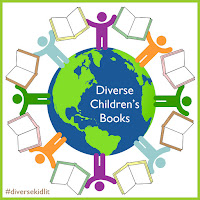The Américas Awards honor authors, illustrators, and publishers for quality children's and young adult books that portray Latin America, the Caribbean, or Latinos in the US. Both primary and secondary reading levels are chosen. This award was founded in 1993.
Click here for more about the Américas Award, including the most recent winners.
A list of all previous winners can be found here.
This post shares my reviews of some wonderful picture books that have won an Honorable Mention or Commended. Click here to read
award-winning picture books or for
winning novels. (To see a compilation of many diverse book awards, please read
Spotlight on Diverse Book Awards or click on the
Award-Winning Books tag.)
Américas Honorable Mention Picture Books
2016:
Funny Bones: Posada and His Day of the Dead Calaveras [Sibert Award winner and a Pura Belpré Honor book]. Written in a similar style to
Diego Rivera, this book combines biography with an interpretation of Posada's works and their application in a modern setting. Our Spanish students often do activities related to Day of the Dead, and this would be a great book to give them more background about how this artistic style developed. (Click on
Part 1 or
Part 2 to read more about other books written and/or illustrated by Duncan Tonatiuh.)
2015:
Migrant: the journey of a Mexican worker (2014) by José Manuel Mateo and illustrated by Javier Martínez Pedro. This book is an incredible work of art. Designed in the style of a codex, the book is one giant illustration that folds down in on itself to become the book. One side has the text in English, the other in Spanish. The story itself is a realistic version of the folktale above, only this time the two children and their mother head north in search of their father who has not returned.
2014:
Pancho Rabbit and the Coyote: a migrant's tale (2013) [a Pura Belpré Honor book]. Written in the style of a fable or folktale, Pancho Rabbit deals with the very real-world issue of illegal immigration from Mexico into the United States. When Pancho's father does not return from "El Norte," Pancho sets out to find him and bring him back, with the help of a coyote he meets along the way.
This was my first year sharing this story with children, and my students and I had some very powerful conversations both before and after reading it. We had studied historical immigration in an earlier unit, so they could make a lot of connections between past and current immigration - and to many of their own family's immigration stories. (Click on
Part 1 or
Part 2 to read more about other books written and/or illustrated by Duncan Tonatiuh.)
2002:
Frida by Jonah Winter is a typical biography with imaginative illustrations that emphasizes Frida's childhood inspirations and injuries and how they impacted her as an artist.
1998:
Cendrillon: a Caribbean Cinderella by Robert D. San Souci and illustrated by Brian Pickney. Another Cendrillon, this one is set in the Caribbean and told through the voice of the godmother, who liberally sprinkles the text with French-Creole words and phrases (glossary provided at the end). This story is loosely based around a nineteenth-century French Creole tale and expanded with historically-appropriate details about life in Martinique. (
Click here to read
more Cinderella stories from around the world.)
Américas Commended Picture Books
2015:
Dalia's Wondrous Hair / El cabello maravilloso de Dalia (2014) by Laura Lacámara. Dalia wakes up one morning to find that her hair has greatly expanding in height and volume, so she does what any little girl would do ... and decides to stick a bunch of things from nature into it to get her mother to guess what kind of tree she is. Wait, what? Even with the folktale-inspired style, I'm still not sure what the point of this story is, though the author does include notes about butterfly gardens and the Cuban plants and animals featured in the story. Bilingual English / Spanish.
2015:
'Twas Nochebuena: a Christmas story in English and Spanish (2014) by Roseanne Greenfield Thong and illustrated by Sara Palacios. This story is a rhythmic take on the famous
Night Before Christmas, focused instead on Nochebuena traditions. The text jumps easily between English and Spanish, with most Spanish words easily understood from the context and illustrations (or, in doubt, from the Glossary in the back). The setting is never made explicit, so the story could just as easily depict a family in the US as one in Mexico or Guatemala (where the author herself experienced Nochebuena). A fun addition to your holiday picture books.
2015:
Green is a Chile Pepper: a book of colors (2014) by Roseanne Greenfield Thong and illustrated by John Parra [a Pura Belpré Honor Book]. This concept book features a given color over one or two two-page spreads with several descriptive statements about objects that are that color, highlighting objects and items common in Latino culture. A detailed glossary at the end provides background on many of these items and events. This would be a great mentor texts for student writing.
2014:
Maria Had a Little Llama / María Tenía una Llamita (2013) by Angela Dominguez [a Pura Belpré Honor Book for Illustration]. The text of this picture book hews closely to the original rhyme (though not all readers might remember the additional stanzas), but the illustrations add a wealth of information in this unique, indigenous take on a classic tale.
Need more?
Click here to read about more Award-Winning Books.

























































